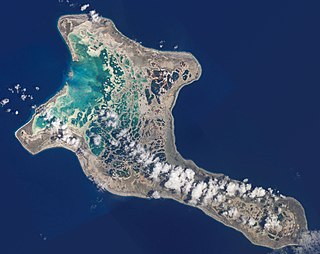
The tiger pistol shrimp belongs to the family of snapping shrimp.
Exyrias akihito is a species of marine goby. Since the recent description of this species it has been found to have a wide distribution in the western Pacific including the Great Barrier Reef, New Guinea, Indonesia, the Philippines and the Yaeyama Islands, Japan. One individual was photographed in Palau, and on January 13, 2005 one was caught in the lagoon of Majuro Atoll in the Marshall Islands. This animal had only 9 soft rays in its dorsal fin instead of the normal 10, a congenital abnormality known to occasionally occur in gobies and other fish.

Nemateleotris magnifica, the fire goby, fire fish, fire dartfish, or red fire goby is a species of dartfish native to the Indian and Pacific oceans from the eastern coast of Africa to the Hawaiian Islands and from the Austral Islands north to the Ryukyu Islands. It is an inhabitant of reefs where it can be found at depths of from 6 to 70 metres. It is usually found just above the bottom, facing into the current, where it awaits its prey of small invertebrates.

Amblyeleotris is a genus of fish in the family Gobiidae found throughout the Indo-Pacific region. This is the largest genus of the shrimp gobies or prawn gobies, so-called because of their symbiotic relationship with certain alpheid shrimps. The shrimp excavates and maintains a burrow used by both animals while the goby, which has far superior eyesight, acts as a lookout for predators. The shrimp maintains almost constant contact with the fish with an antenna.These species vary considerably in size from less than 30 mm to almost 200 mm standard length.
Amblyeleotris rubrimarginata is a species of goby found on reefs or in sea grass beds in the western Pacific from New Caledonia to the Great Barrier Reef and around New Guinea, Indonesia, Malaysia and the Philippines. It can be found at depths of from 3 to 26 metres. As with other Amblyeleotris species, it has a symbiotic relationship with alpheid shrimps, one or a pair of gobies sharing a burrow with a pair of shrimps.
Amblyeleotris marquesas is a species of goby only recorded from reefs around Nuku Hiva in the Marquesas Islands, French Polynesia in the central Pacific Ocean at depths of 20 to 25 metres. As with other species of their genus, this species has a symbiotic relationship with alpheid shrimps, in this case Alpheus randalli, one or a pair of gobies sharing a burrow with one or a pair of shrimps.

Brachygobius is a small genus of gobies. They are popular aquarium fish where a number of species are sold as bumblebee gobies because their colours are similar to those of bumblebees.

Amblyeleotris steinitzi, Steinitz' prawn goby or simply Steinitz' goby, is a species of small fish in the family Gobiidae. It lives in association with an alpheid shrimp and is found from the Red Sea through the Indian Ocean to the western Pacific Ocean.
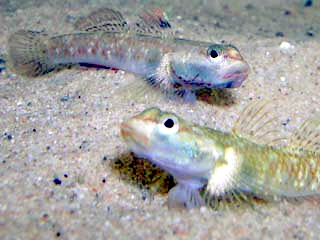
The Gobiiformes are an order of fish that includes the gobies. The order, which was previously considered a suborder of Perciformes, is made up of 2,211 species that are divided into seven different families. Phylogenetic relationships of the Gobiiformes have been elucidated using molecular data. Gobiiforms are generally small fish and are mostly marine (saltwater) fishes, but roughly 10% of the population inhabit fresh waters. This order is made up of mainly benthic or sand-burrowing fish. Benthic fish live on the bottom of a body of water. Like in most benthic organisms, gobiiforms do not have a gas bladder or swim bladder which keeps them from suspending in the water column, so they must stay on the bottom.

Ptereleotris hanae, the blue hana goby, is a species of dartfish native to the western Pacific Ocean. It is a reef inhabitant, being found at depths of from 3 to 50 metres, though usually no shallower than 6 metres (20 ft). It inhabits burrows made by alpheid shrimp, but unlike the Amblyeleotris gobies who normally associate with these shrimp, this species has no interactions with their shrimp hosts. This species can reach a length of 12 centimetres (4.7 in) TL. It can also be found in the aquarium trade.

Amblyeleotris guttata, theSpotted prawn-goby is a species of goby native to reefs of the Western Pacific Ocean, that includes the Philippines to Tonga, north to the Ryukyu Islands, south to Australia.
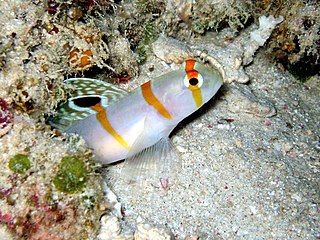
Amblyeleotris randalli, Randall's prawn goby, is a marine benthic species of goby native to tropical reefs of the central Indo-Pacific. This species can also be found in the aquarium trade.

Amblyeleotris wheeleri, the Gorgeous prawn-goby, is a species of goby native to tropical reefs of the Indian Ocean to the western Pacific Ocean. It can be found at depths of from 5 to 40 metres though is usually does not occur deeper than 15 metres (49 ft). It is a commensal with alpheid shrimps, most often being found in association with Alpheus ochrostriatus. This species can reach a length of 10 centimetres (3.9 in) SL. It can also be found in the aquarium trade. The specific name honours the English ichthyologist Alwynne Cooper Wheeler (1929-2005), who was curator of Fishes at the British Museum, "for his help over the years, particularly with the authors’ study of prawn-associated gobies of the Seychelles".

Amblyeleotris diagonalis, the Diagonal shrimpgoby, is a species of goby native to the Indian Ocean and the western Pacific Ocean where it can be found on reefs at depths of from 6 to 40 metres. It is commensal with alpheid shrimps. This species can reach a length of 11 centimetres (4.3 in) SL.
Amblyeleotris aurora, the pinkbar goby, is a species of goby native to reefs of the western Indian Ocean at depths of from 5 to 40 metres though usually not deeper than 10 metres (33 ft). It is commensal with the shrimp Alpheus randalli. This species can reach a length of 11 centimetres (4.3 in) TL. It can also be found in the aquarium trade.

Alpheus randalli is a species of snapping shrimp in the genus Alpheus. It lives in the Marquesas Islands and parts of the Indian Ocean, including the Seychelles, in association with a goby of the genus Amblyeleotris. The shrimp is transparent or white with prominent red markings.

Oplopomus oplopomus, commonly known as the spinecheek goby, is a species of goby native to the Indo-Pacific region. They can grow to a maximum length of 10 centimetres (3.9 in). They inhabit coral reefs.
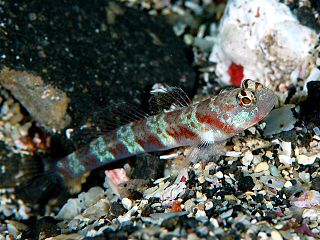
Amblyeleotris periophthalma, the broad-banded shrimp goby or the periophthalma shrimp goby, is a marine benthic species of goby native to reef environments of the Indo-West Pacific, Red Sea included.
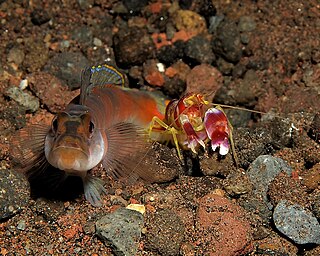
Amblyeleotris yanoi is a marine benthic species of goby native to reef environments of the western Pacific Ocean. It is a small sized fish that can reach a maximum size of 13 centimetres (5.1 in) length for males and 5 centimetres (2.0 in) for females.

